ARTICLE C. DESIGN PROVISIONS FOR NONRESIDENTIAL STRUCTURES
SECTION:
8-4C-3: General Provisions For Nonresidential Development
8-4C-4: Special Provisions For Specific Nonresidential Development
8-4C-1: PURPOSE:
The purpose of the nonresidential design provisions is to improve the image, economic vitality, and long term sustainability of nonresidential development within the city. Specifically, these provisions are intended:
A. To create development that creates a sense of place and contributes to the uniqueness of the different districts and neighborhoods within the city;
B. To improve the accessibility of development to nonmotorized and public modes of transportation;
C. To encourage a development pattern in nodes rather than strip commercial along arterial corridors;
D. To set in place a compact development pattern that enables intensification of development and changes over time;
E. To encourage a process for development of property that provides certainty and flexibility to applicants and property owners;
F. To provide outdoor spaces and landscaping compatible with the southwest Idaho climatic conditions and that encourage pedestrian activity. (Ord. 898-08, 9-8-2008)
8-4C-2: APPLICABILITY:
This article sets forth provisions that apply to development in the highway commercial (C-1) and general commercial (C-2) zoning districts, and any commercial building in the light industrial (LI) zoning district and/or any nonresidential development in any zoning district. The provisions apply to the various forms of development including: new construction, major and minor alterations, large scale construction, and development in specific locations as follows: (Ord. 944-12, 5-14-2012)
A. New Construction: For any new construction, the requirements of this article shall apply to all parts of the building and lot.
B. Structural Addition: For any structural addition that adds more than twenty five percent (25%) increase in gross floor area of the existing building, all of the building shall be brought into conformance with the requirements of this article.
C. Storefront Renovations: Any storefront renovations, where more than twenty five percent (25%) of the facade of the store is altered, replaced, rehabilitated or restored, shall comply with subsections 8-4C-3A4, 8-4C-3C, E, and F, and section 8-4C-5 of this article. (Ord. 898-08, 9-8-2008)
D. Lot Improvements: Any lot improvements that changes or cumulatively changes more than twenty five percent (25%) of the site area within a twenty four (24) month period shall be required to conform to subsections 8-4C-3B and D of this article.
E. Exceptions: This chapter does not apply to any new accessory structure that is less than twenty five percent (25%) the assessed value of the principal structure and is not located in the front or street side yard. (Ord. 944-12, 5-14-2012)
8-4C-3: GENERAL PROVISIONS FOR NONRESIDENTIAL DEVELOPMENT:
The provisions that follow establish an objective statement followed by guidelines for meeting that objective. In any situation, there may be a range of alternative methods for achieving the objective. The design review process set forth in chapter 6, "Administration", of this title provides the process for allowing innovation and creativity in meeting the development design objectives.
A. Objective 1: The design of all structures shall have a scale, massing and urban form that has a relationship to the street, the pedestrian, and adjacent properties.
1. Floor Area Ratio (FAR): All new construction should have a minimum floor area ratio of 1.0 or a minimum of two (2) stories.
Figure 8-4C-1
Three Different Ways To Achieve FAR 1.0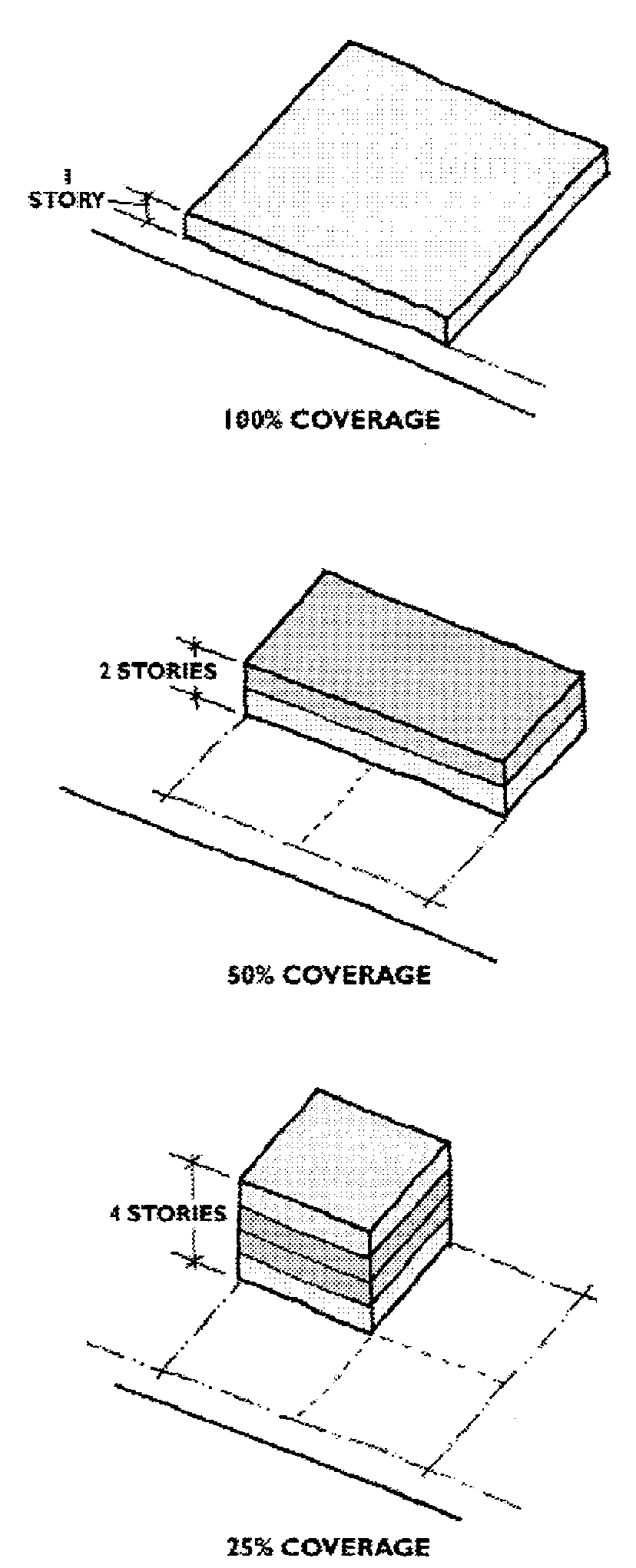
2. Street Setback: The maximum front setback is fifteen feet (15') from curb edge for a minimum of sixty percent (60%) of the length of the street frontage. (Ord. 898-08, 9-8-2008)
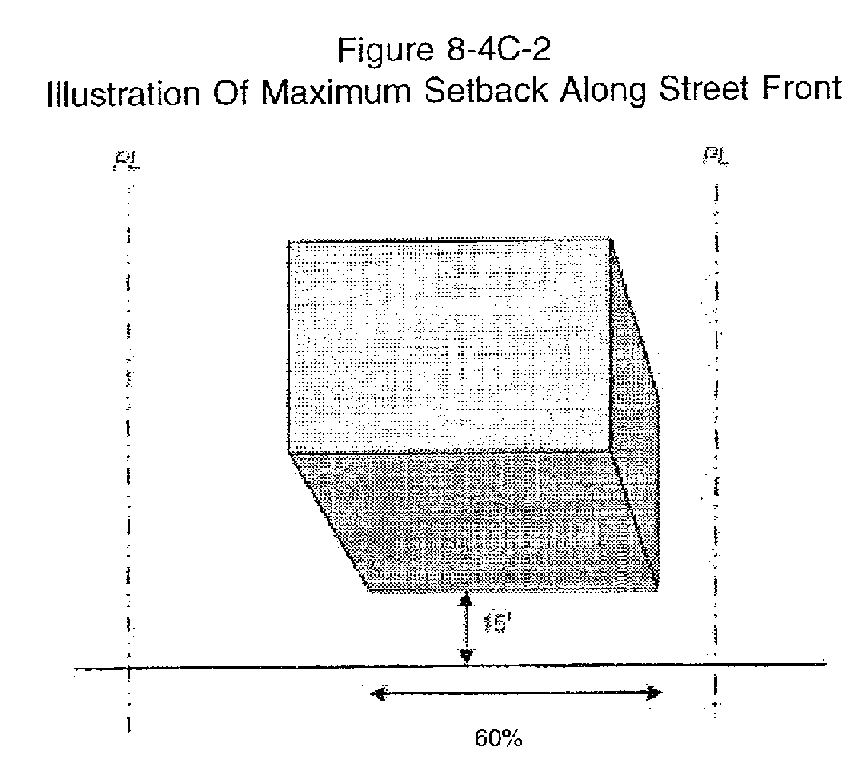
(Ord. 898-08, 9-8-2008; amd. Ord. 905-09, 3-23-2009)
a. On parcels with more than one building, the maximum allowable street setback applies to the front elevation of the building closest to the public street.
b. The street setback may be increased when a plaza is provided with a minimum area of five hundred (500) square feet and meeting the criteria for public space as set forth in subsection 8-4C-4C of this article.
Figure 8-4C-3
Plaza Example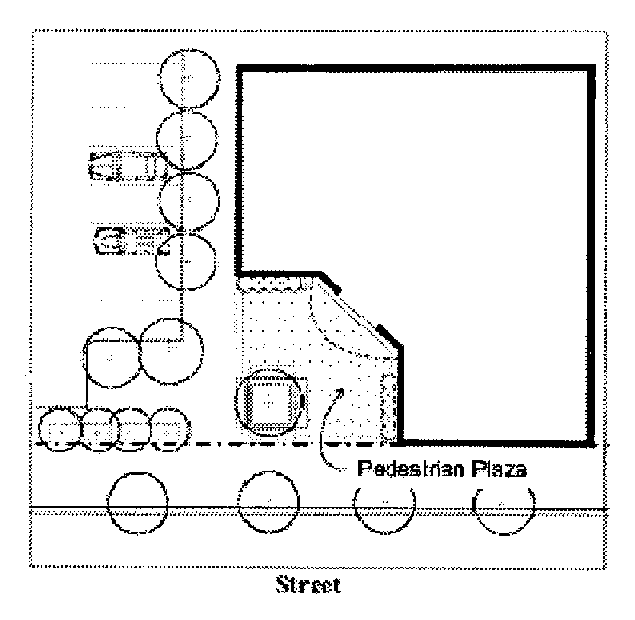
3. Street Frontage: Sixty percent (60%) of the street frontage along the front setback should be occupied by a structure or a plaza.
Figure 8-4C-4
Two Different Ways To Achieve Street Frontage Examples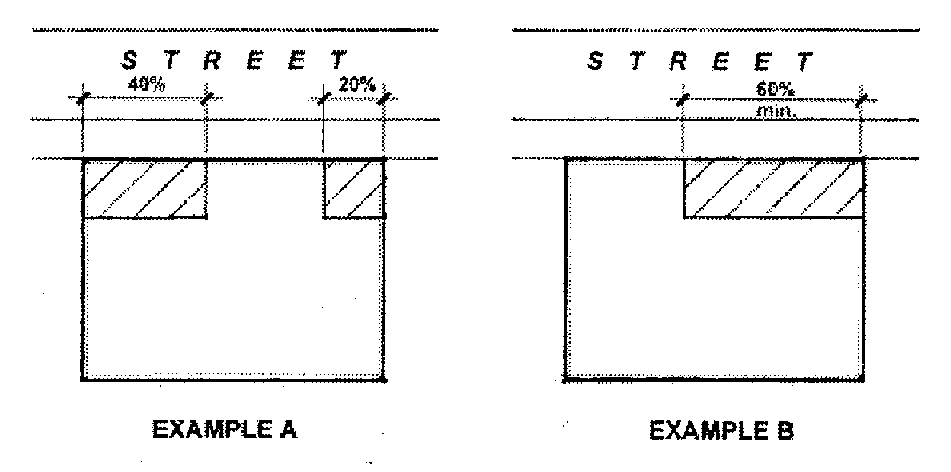
4. First Floor Facades: First floor facades visible from a public street should include surfaces in windows, showcases, displays, or pedestrian access elements as follows: for retail uses at least fifty percent (50%), for all other uses at least fifteen percent (15%).
5. Upper Story Facades: Upper story facades should be set back ten feet (10') where the location is adjacent to a residential district.
6. Wall Plane: Facades should have no wall plane wider than two and one-half (21/2) times the height of the wall plane. If a new wall plane is required to achieve compliance with this requirement, it must be offset by at least six feet (6').
Figure 8-4C-5
Acceptable And Not Acceptable Wall Plane Dimensions Examples
7. Blank Walls: No blank walls should front a public street. Any blank walls should be treated in one or more of the following ways:
a. Installing a vertical trellis in front of the wall with climbing vines or plant materials; or
b. Providing a landscaped planting bed at least five feet (5') wide or raised planter bed at least two feet (2') high and three feet (3') wide in front of the wall, with plant materials that obscure or screen at least fifty percent (50%) of the wall’s surface within three (3) years;
c. Providing artwork (mosaic, mural, sculpture, relief, etc.) over at least fifty percent (50%) of the blank wall surface.
Figure 8-4C-6
Vertical Trellis And Landscaping Treatment On Blank Wall Example
B. Objective 2: The design layout of all sites shall maximize opportunities for safe and comfortable pedestrian accessibility and minimize the obtrusive effects of parking and vehicular circulation.
1. Parking Lot Locations: All parking lots should be located to the side and rear of the building fronting on the street. A parking lot may be located between a building and a street when the visual effect of the parking lot has been mitigated by one of the following ways:
a. The lot is a minor component in a large site development and is no wider than one parking bay and one driveway lane; or
b. The site design demonstrates that the parking lot is well integrated with the overall site design and pedestrian connections and amenities have been provided that compensate for the parking lot location; or
c. A minimum of ten feet (10') of landscaping has been provided between the parking lot and the view of the surface lot from the street is minimized; or
d. The parking lot is designed with materials and landscaping that softens the appearance of the parking lot.
2. Driveway Lanes: Driveway lanes crossing a public sidewalk should be no wider than twenty feet (20') and the minimum of feet between driveway intersections with the public street as set forth by the transportation authority. Driveway lanes crossing a public sidewalk intersection should be clearly distinguished with special pavement or coloring.
3. Pedestrian Pathways:
a. Pedestrian pathways should be designed to provide a direct connection between the main building entrance and the public sidewalk.
b. Direct, convenient, and attractive pedestrian pathways should be provided that are clearly marked and connect all portions of the site.
c. Pedestrian pathways should be functionally separate from parking lots and driveways except where they cross driveways.
d. No access to a parking space should require a pedestrian to cross more than one drive aisle and two (2) parking bays of parking. Pedestrian pathways that are flush or shared with driveways, or pathways that cross surface parking lots longer than one drive aisle and two (2) parking bays in distance should be visually distinct from parking lot and driveway surfaces by either: 1) a distinct pattern and texture (e.g., brick pavers or stamped concrete) in paving materials; or 2) a raised surface.
Figure 8-4C-7
Distinctive Texture Pattern On Pedestrian Walkway Flush With Driveway Example
4. Primary Entrance:
a. The building closest to the street should have its primary entrance to the street and be clearly defined by the architectural design of the building.
b. The primary entrance of all buildings should provide a covered pedestrian open space such as a building recess, an awning, canopy or marquee.
c. Pedestrian amenities should be provided at the entrance including a minimum of one hundred (100) square feet of landscaping, outdoor seating, plazas, courtyards, public art, fountains, special paving, bicycle racks, transit stop.
C. Objective 3: Buildings shall be designed and constructed of quality materials.
1. Suitable Materials: Materials should be selected for suitability to the type of building and design for which they are used.
2. Encouraged Materials: Quality finish materials should be utilized, including, but not limited to, brick, masonry, or stone integrally tinted, textured masonry block, stucco, wood, or concrete siding.
3. Discouraged Materials: Metal siding, corrugated fiberglass, aluminum siding, mirror or metalized reflective glass, plywood, chipboard siding, vinyl, cinderblock, plastic tilt-up concrete, highly tinted or mirrored glass, and all types of imitation building materials should not be used as the primary building material.
4. Discouraged Finishes: Finishes that reflect light and glare; or bright, heavily saturated and/or reflective shades of primary colors are discouraged.
5. Change In Materials: Piecemeal embellishment and frequent changes in material should be avoided.
6. Matched Colors: The color of roof stacks, flashing, vents, power exhaust fans, and metal chimney caps should blend with the roof colors.
D. Objective 4: The site design shall respect existing notable site features including existing buildings, landscaping, trees and water.
1. Maintenance Of Existing Vegetation: All existing trees, significant vegetation and surface water features should be maintained.
2. Fifty Year Old Buildings: Buildings over fifty (50) years old that are safe and habitable should be maintained. (Ord. 898-08, 9-8-2008)
3. Scraped Sites:
a. Any existing site that is entirely scraped of existing natural and structural site conditions, should meet the requirements set forth in article I, "Landscaping And Tree Protection Provisions", of this chapter and should be well integrated with the site design. (Ord. 905-09, 3-23-2009)
b. Any existing site that is entirely scraped of existing natural and structural site conditions in which a natural waterway, irrigation canal, lateral or drain has previously been tiled or piped should meet the requirements set forth in section 8-4A-13, "Waterways", of this chapter. (Ord. 898-08, 9-8-2008; amd. Ord. 905-09, 3-23-2009)
E. Objective 5: The design of all buildings shall provide visual interest, support the vision for the area as articulated in the comprehensive plan and positively contribute to the overall urban fabric of the community.
1. Building Orientation: Buildings should be oriented to a prominent feature, such as a corner location, a plaza, a street or the river. Buildings and site design should provide inviting entry orientation. Buildings should not turn their backs to the street.
2. Articulation: Buildings should be articulated to reduce the apparent scale. Architectural details that are used to articulate the structure may include reveals, battens, and other three-dimensional details that create shadow lines and break up the flat surfaces of the facade. The following are ways to achieve building articulation:
a. Window Treatments: Provide ample articulated window treatments in facades visible from streets and public spaces for architectural interest and human scale. Windows should be articulated with mullions, recesses, etc., as well as applying complementary articulation around doorways and balconies.
b. Architectural Elements: The mass of long or large scale buildings can be made more visually interesting by incorporating architectural elements, such as arcades, balconies, bay windows, dormers, and/or columns.
c. Rooflines: A distinctive roofline can reduce perceived building height and mass, increase compatibility with smaller scale and/or residential development, and add interest to the overall design of the building.
(1) Change the roofline by alternating dormers, stepped roofs, gables, or other roof elements to reinforce the modulation or articulation interval.
(2) Roofs that incorporate a variety of vertical dimensions such as multiplaned and intersecting rooflines are encouraged.
(3) Flat roofed designs should include architectural details such as cornices, and decorative facings to provide interest to the roofline.
3. Building Details: The design of buildings should be enhanced with appropriate details. The following elements are examples of techniques used on buildings to provide detail:
a. Ornate Rooflines: Examples include ornamental molding, entablature, frieze, or other roofline devices.
b. Detailed Treatment Of Windows And Doors: Examples include decorative lintels, sills, glazing, door design, molding or framing details around all windows and doors located on facades facing or adjacent to public streets or parks. Window sizing and treatment should be as follows:
(1) Windows should not have individual glass panes with dimensions greater than five feet by seven feet (5’ x 7').
(2) Windows should be surrounded by trim, molding and/or sill at least four inches (4") wide. Commercial buildings with no trim or molding should have window frames at least two inches (2") wide.
(3) Individual window units should be separated from adjacent window units by at least six inches (6") of the building’s exterior finish material.
c. Ornamentation: Examples include ornamental railings, grillwork, landscape guard, and trellises.
d. Distinctive Light Fixtures: Examples include lights with a decorative shade or mounting.
e. Artwork Or Decorative Paving: The artwork may be freestanding or attached to the building, and may be in the form of mosaic, mural, bas-relief sculpture, light sculpture, water sculpture, fountain, freestanding sculpture, art in pavement, or other similar artwork.
4. Colors: Colors used on building exteriors should integrate a building’s various design elements or features.
a. Accent colors should use color combinations that complement each other.
b. Use accent colors in a way to enhance or highlight building design, and not in a manner that creates clutter or otherwise detracts from building design.
c. The use of bright colors should be avoided. Softer, muted or earth toned colors are preferred.
d. Colors should be compatible with the architectural character of the surrounding buildings and neighborhood.
5. Use Of Certain Building Features Or Design Elements Discouraged: The use of building features or design elements that overemphasize corporate themes, logos, or colors which stand above the neighborhood and community context without adding functional or aesthetic value to the building context should be discouraged. See section 8-4C-5, "Prohibitions", of this article.
F. Objective 6: The site development should support and be consistent with the adopted streetscape. (Ord. 898-08, 9-8-2008)
8-4C-4: SPECIAL PROVISIONS FOR SPECIFIC NONRESIDENTIAL DEVELOPMENT:
A. Large Scale Nonresidential Structures:
1. Facades longer than fifty feet (50') (measured horizontally along the facade) should incorporate relief to perceived building mass through such features as wall projections or recesses, projecting windows, entrances, or other visual relief. The doorways on buildings abutting or within three feet (3') of the sidewalk should be recessed in order to avoid conflicts with pedestrians.
Figure 8-4C-8
Mitigating Building Mass Example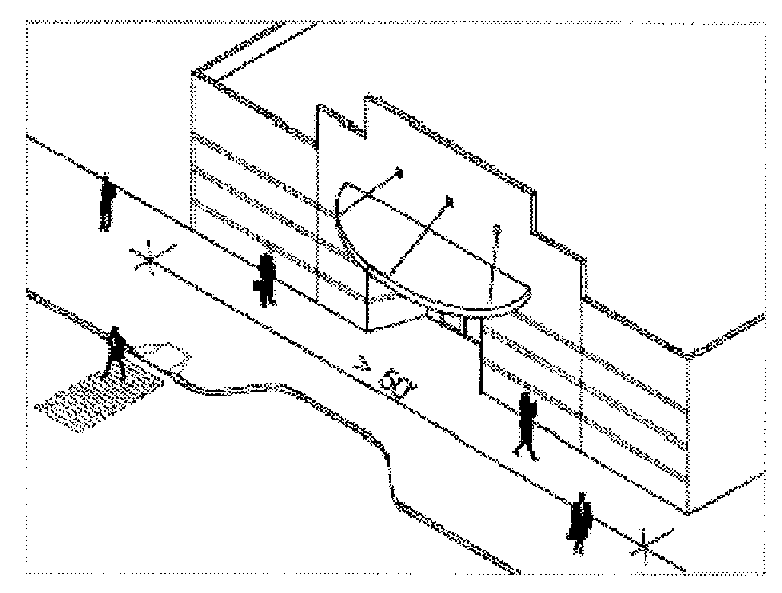
2. Rooflines exceeding fifty feet (50'), should incorporate relief to the perceived building mass by providing roofline variation. Roofline variation should be achieved using one or more of the following methods: a) vertical offset in ridgeline; b) horizontal offset in ridgeline; c) variations in roof pitch; d) gables; and e) dormers.
Figure 8-4C-9
Methods To Provide Roofline Variations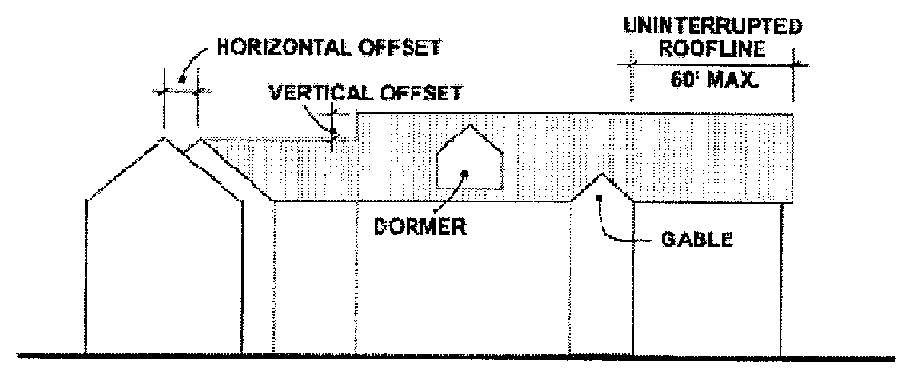
B. Multiple Nonresidential Structures On One Development Site:
1. Pedestrian Pathways: All portions of a site should be accessible by a direct, convenient, attractive, safe and comfortable system of pedestrian pathways as follows:
a. A pedestrian pathway provides a direct route between building and the public sidewalk.
b. A pedestrian pathway is free from hazards and has appropriate lighting levels.
c. Pathway layouts should promote the shortest distance between building entrances. Long circuitous routes should be avoided.
d. Secondary pathways must be at least three feet (3') in width.
Figure 8-4C-10
Internal Pedestrian Circulation Example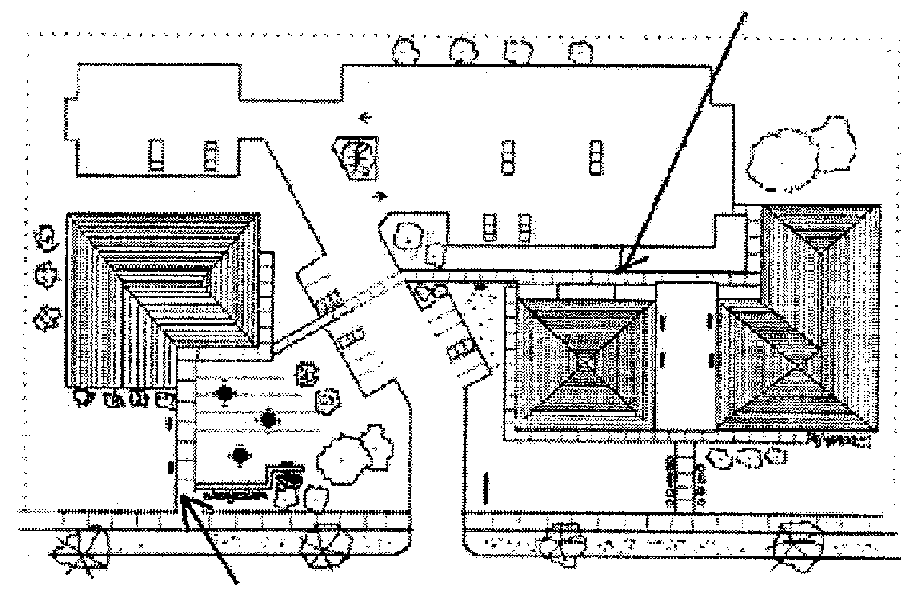
2. Consistent Setbacks: Consistent setbacks to the front or internal parking areas should be provided to create an organized spatial enclosure.
Figure 8-4C-11
Front And Internal Parking Area Setback Examples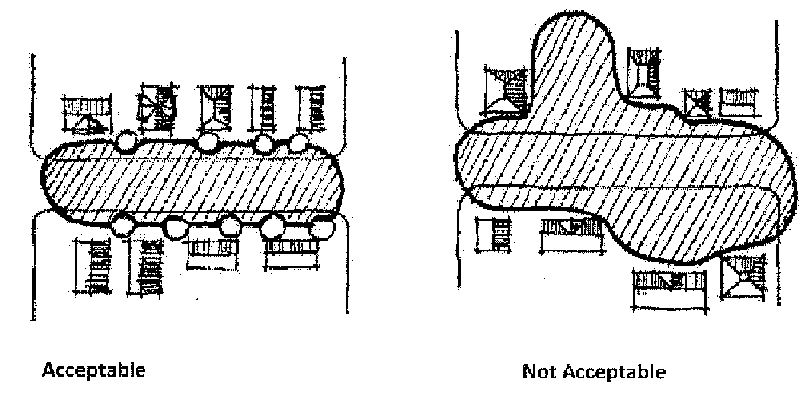
3. Terminal Views: Terminal views within the site should be provided to landscaping, landmarks or significant site features.
Figure 8-4C-12
Terminal View Examples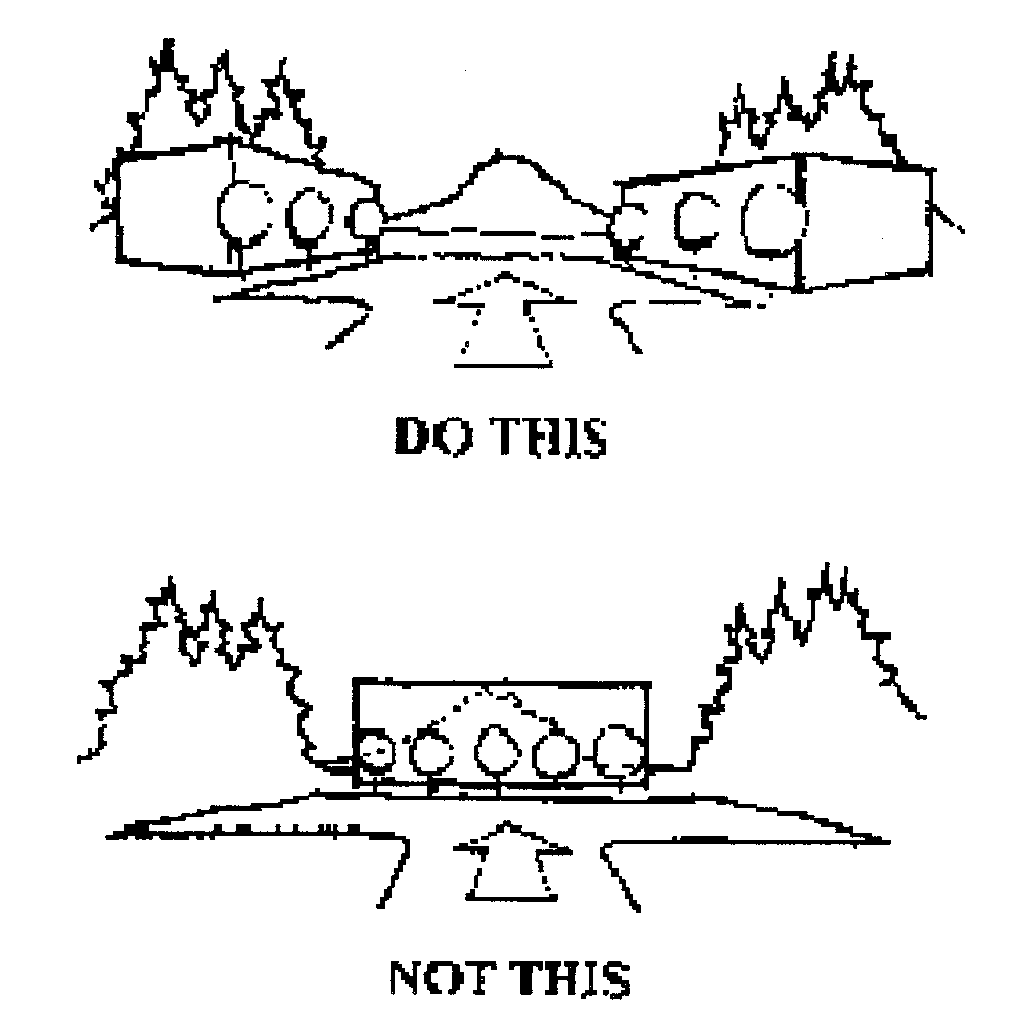
4. Visual Continuity: Visual continuity should be achieved between dissimilar buildings by emphasizing common elements of site design (landscaping, screening, furnishings, light standards, decorative paving materials).
C. Plaza Requirements:
1. To qualify as a pedestrian plaza, an area should have:
a. Pedestrian access (including handicapped access) into the plaza from the public right of way.
b. Paved walking surfaces such as concrete, brick pavers, or other type of pavers on level, stepped, or gently sloping (less than 3 percent grade).
c. One linear foot of seating per perimeter linear foot of the plaza.
d. Security lighting on site or building mounted.
e. A minimum size of five hundred (500) square feet with the shorter dimension of a plaza less than three (3) times the height of surrounding buildings.
f. Buildings on plazas should promote and accommodate outdoor activity with balconies, arcades, terraces, decks, and courtyards for residents’ and workers’ use and interaction.
g. Distributed trash containers around the plaza.
h. Direct access to occupied indoor space.
i. Located so that the build provides buffering from street noise when the location is on a major arterial.
2. A pedestrian plaza is encouraged to have:
a. Site furniture:
(1) Seating may be on planters, rails, benches, retaining walls and other raised surfaces.
(2) Cluster and movable seating for informal gathering and outside eating areas.
(3) Locate seating for sun exposure, where views can be taken advantage of, and near to activity centers of a site such as at building entrances and at the intersection of walkways.
b. Artwork, or amenities such as fountains, kiosks:
(1) Interactive art, sculpture, and fountains which people can touch and move.
(2) Fountains for visual attraction, to screen traffic noise, and for cooling effects.
3. A pedestrian plaza should not be located adjacent to unscreened parking lots or blank walls without wall treatment as set forth in subsection 8-4C-3A7 of this article.
D. Awning, Marquee And Arcade Requirements:
1. Awning, marquee, or arcades should be at least four feet (4') and six inches (6") deep, over the full length of sidewalk or walkway adjacent to the building, and minimum eight feet (8') above the walkway level.
Figure 8-4C-13
Awning, Marquee And Arcade Design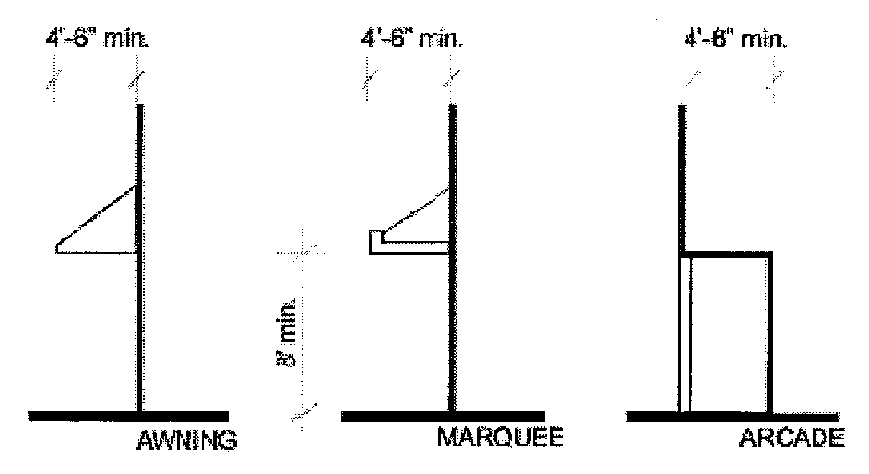
2. The shape, color and location of the awning, marquee or arcade should be consistent with the architectural design of the building.
3. Awnings, marquees or arcades which are used as an integral and creative form of signage should be encouraged.
4. Awnings, marquees or arcades with distinctive shapes such as barrel shape, segmented arches, or round ended should be carefully used.
5. Awnings, marquees or arcades which dominate the facade, run the entire length of the building, obscure the architectural features of the building, and which are illuminated with fluorescent lighting should be discouraged.
E. Murals:
1. The content of the mural is consistent with the architectural, geographical, sociocultural and historical context of the city.
2. The location is on the rear, side or alley side of the building.
3. The size of a mural may be limited based on the location, building and context.
4. The surface material is resistant to vandalism and weather.
F. Outdoor Service And Equipment Areas:
1. HVAC equipment, trash dumpsters, trash compaction, and other service functions should be incorporated into the overall design of buildings and landscaping so that the visual and acoustic impacts of these functions are fully contained and out of view from adjacent properties and public streets.
2. All on site service areas for waste, recycling, or trash; and equipment areas for transformer and utility vaults should be located in an area not visible from a public street or adjoining property, or should be fully screened from view from a public street and adjoining property with a privacy fence.
Figure 8-4C-14
Examples Of Location And Screening Of Service And Mechanical Equipment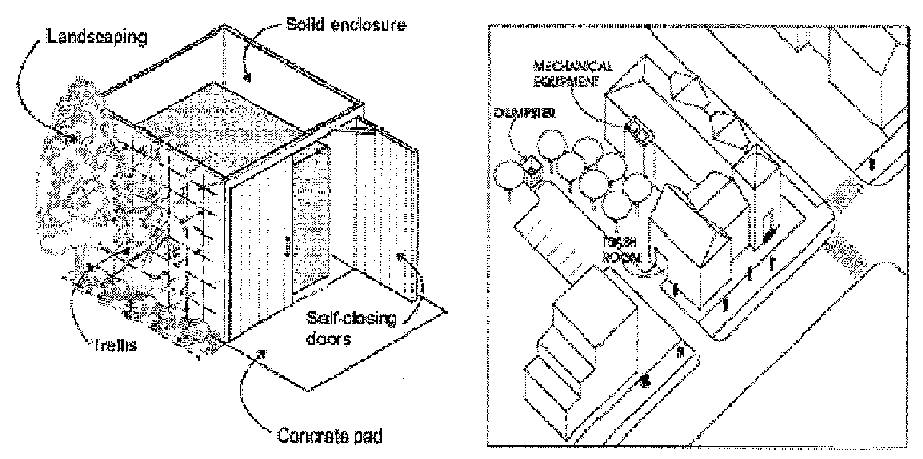
Figure 8-4C-15
Example Of Screening Mechanical Equipment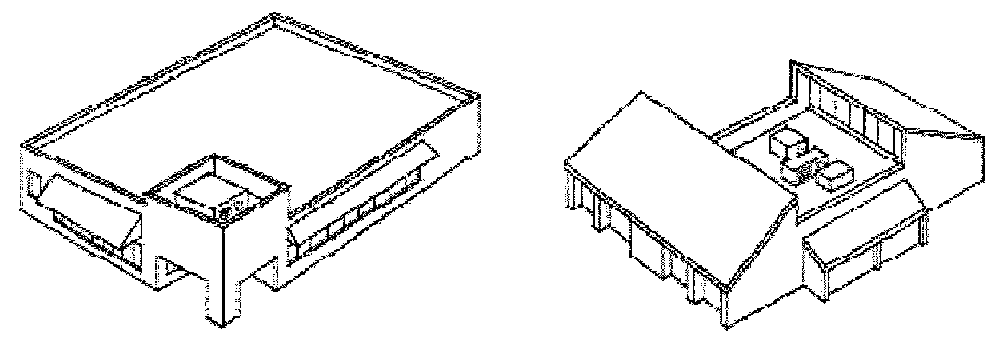
(Ord. 898-08, 9-8-2008)
8-4C-5: PROHIBITIONS:
A. Stylized Buildings: Garden City respects that independent businesses, corporations and franchises use specific architectural designs to identify their businesses and attract customers. The city encourages independent businesses, corporations and franchises to build locations in Garden City using architectural designs that comply with this code, conform to the city’s comprehensive plan and goals, and complement surrounding structures. All new business, corporate and franchise designs are reviewed by design review consultant(s) to assure compliance with these plans and goals.
Figure 8-4C-16
Example Of Stylized Building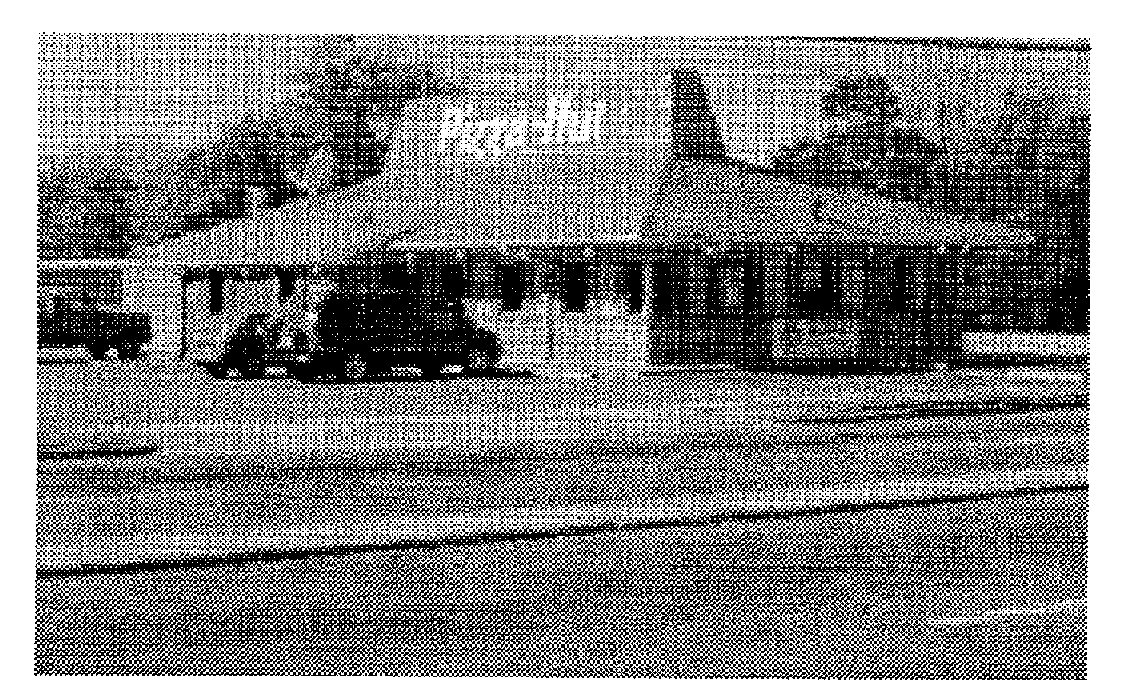
B. Visible False Fronts: False fronts that are not tied into the rest of the building, that are designed so that the ends are visibly separate from the building.
Figure 8-4C-17
Example Of Visible False Front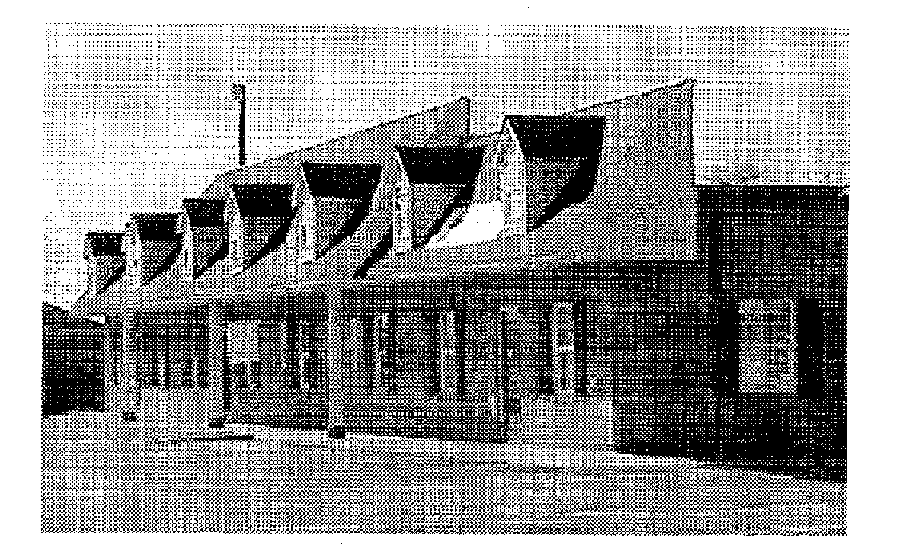
C. Prefabricated Structures:
1. Principal and accessory structures visible from the right-of-way that are made of prefabricated materials such as shipping containers or pre-engineered metal buildings unless they contain architectural features and a variety of materials so that they lose the appearance of being a prefabricated structure.
D. Prohibited Materials: Crushed colored rock/crushed tumble glass are prohibited site improvement materials unless it is found that the material is insignificant in the design or provides significant creativity and uniqueness. (Ord. 898-08, 9-8-2008; amd. Ord. 1002-18, 1-28-2019; Ord. 1026-22, 9-12-2022)


